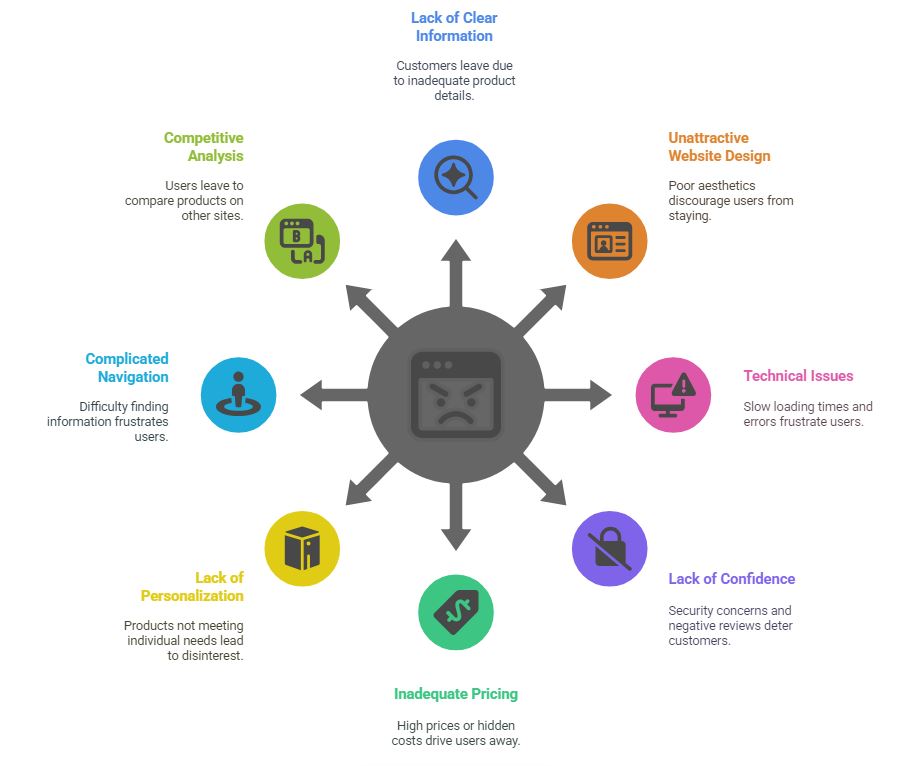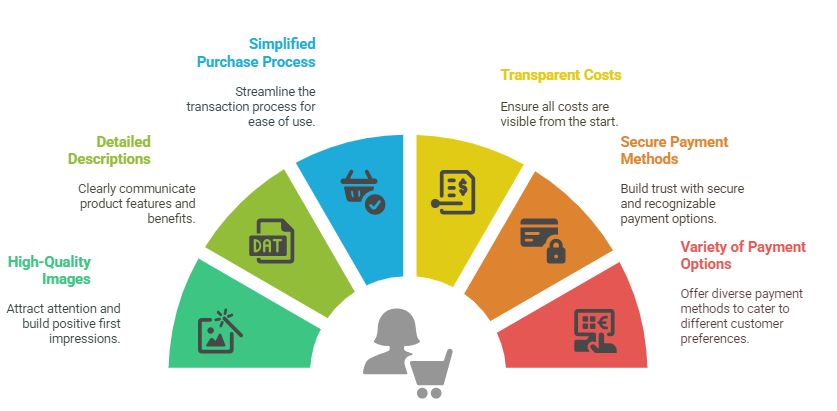- Research platform
Sources of information
Data analysis
Actions
- Solutions
For whom
Problems / Issues
- Materials
Materials
- About us
About us

Imagine someone visits your website, browses through your products, maybe even lingers on a few items... and then suddenly disappears without a trace. They leave behind empty paths in your analytics-no items added to the cart, no purchases made. This scenario is all too familiar to online store owners. While much attention is given to abandoned shopping carts, there’s an equally important challenge: product browsing abandonment early in the shopping journey.
Why does this happen? There are many possible reasons: unintuitive navigation, slow page load times, unclear information, or an unfriendly site design. Users quickly lose patience if they can't find what they want or run into technical issues. The result? A high bounce rate, which for e-commerce means lost sales opportunities and a tougher path to building customer loyalty.
In this article, we’ll take a closer look at the phenomenon of browsing abandonment. We’ll examine which elements of online stores can discourage visitors, and how-by analyzing user behavior and personalizing communication-you can effectively win back their attention, whether they’re new or returning customers. You’ll learn how to improve the shopping experience, use automated reminder messages (email and SMS), and discover strategies to turn casual browsers into loyal customers. If you want your offer to stand out and keep visitors coming back, this article is for you.
Browsing abandonment occurs when a potential customer enters your online store, looks at products-maybe even a few catch their eye-but then leaves the site without making a purchase. This is a real challenge for e-commerce: every instance represents a potential lost sale and lost revenue.
One of the most common reasons customers abandon their journey is a complicated purchase process. The more obstacles between them and completing a purchase, the more likely they are to give up. Fortunately, there are effective ways to counteract this. One of them is automated abandonment reminder messages, which can successfully bring undecided users back to your store.
The key to success is understanding why customers leave and implementing solutions that make it easier for them to complete their purchase. Streamlining the shopping process, clear communication, and analyzing user behavior can significantly reduce browsing abandonment and increase conversion rates. It’s worth taking action-every recovered opportunity brings you closer to building a strong, loyal customer base.
Product abandonment in online stores is a daily reality for every retailer. Customers browse, add products to their cart, but ultimately decide not to complete the transaction. This phenomenon highlights the gap between interest in an offer and actual sales. The statistics are clear-up to 70% of online transactions end with cart abandonment, leading to real losses and lower conversion rates.
Why do customers abandon their carts? The most common reasons include high shipping costs, hidden fees, mandatory account creation, lack of preferred payment methods, or long delivery times. However, before they even abandon their cart, many customers leave at the product browsing stage. That’s why it makes sense to focus on optimizing the shopping process and removing barriers that might discourage them from staying on your site.

Understanding why visitors abandon your site during the product browsing stage is crucial for improving your store’s performance. Here are the most common reasons:
Being aware of these barriers allows retailers to respond more effectively. Simplifying and improving product pages, ensuring transparency, and building trust are the foundations for retaining visitors and converting them into loyal customers.
The product page is the heart of any online store-it’s where potential customers decide whether to stay or leave. That’s why optimizing product descriptions, using attractive photos, and ensuring a clear design are crucial to reducing abandonment.

More and more customers use mobile devices to browse and shop online. That’s why mobile optimization and responsive design are essential to reduce abandonment rates.
With these measures, you can significantly reduce the number of users who abandon your site during product browsing on mobile devices, leading to higher conversion rates and greater customer satisfaction.
One of the most effective ways to reduce product page abandonment is to personalize the shopping experience. Customers appreciate it when an online store understands their needs and tailors offers to their preferences. By analyzing previous visits and behavior, you can present product recommendations that genuinely interest them. Personalized offers and promotions not only attract attention but also increase the likelihood that visitors will stay longer and return in the future.
Tailoring the shopping process to customer expectations-such as remembering preferred payment methods or delivery addresses-makes users feel valued and less likely to leave. Always ensure personal data is safe; clear communication about this builds trust and encourages further browsing.
Campaigns targeting users who interrupted their browsing are essential for e-commerce success. Automated emails or SMS messages can remind customers of products they viewed and encourage them to return. These actions not only help recover unfinished purchases but also provide a chance to win back those who left before deciding to buy.
Messages can be triggered when a user views a specific product page or searches for a particular category. This makes communication relevant and builds positive associations with your brand. Well-planned remarketing campaigns can significantly increase conversion rates-even if the user wasn’t ready to buy during their first visit.
Browsing abandonment emails are a powerful tool for regaining visitors’ attention. They remind users of products that caught their interest and encourage them to return. Personalizing these messages-by referencing specific products or offering an extra discount-increases their effectiveness and builds customer relationships.
Statistics show that up to half of recipients open such messages, and about 10% return to complete their purchase. This proves it’s worth investing in this communication channel, especially if you want to reduce product page abandonment.
To be effective, a browsing abandonment reminder email must be personalized and engaging. Use product recommendations based on past behavior, emphasize urgency (e.g., limited-time offers), or provide an exclusive discount. Attractive visuals and a clear call to action that directs the customer back to the product page are also essential.
Segmenting your audience and tailoring subject lines to individual interests increases the likelihood of opens and clicks. These actions not only help recover sales but also build a positive buying experience.
Alongside emails, SMS marketing is becoming increasingly important for user recovery. Text messages have a very high open rate and allow you to instantly reach customers who have left a product page. An SMS with a link to the viewed offer, a personalized recommendation, or information about a promotion is an effective way to encourage customers to return.
Integrating SMS with email campaigns as part of a multi-channel approach further increases the effectiveness of remarketing. Market examples show that such activities can boost conversions by up to 20% among users who left a product page without buying.
To effectively reduce product page abandonment, apply these proven strategies:
To effectively reduce browsing abandonment, you need to understand what behaviors lead users to leave product pages. The most common reasons include:
Regularly analyze these behaviors, test different solutions, and monitor the impact of changes. Even small improvements-like better images, faster loading, or clearer labels-can significantly reduce abandonment and increase conversion rates.
Product browsing abandonment is a hidden but very real problem in e-commerce. The key to reducing it lies in understanding the causes, optimizing product pages, personalizing communication, and effectively using emails and SMS to win back customers. By focusing on visitor behavior and continually improving the shopping experience, you can not only keep users on your site but also increase conversion rates and build brand loyalty.
Copyright © 2023. YourCX. All rights reserved — Design by Proformat